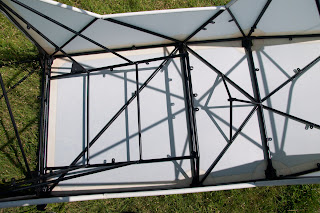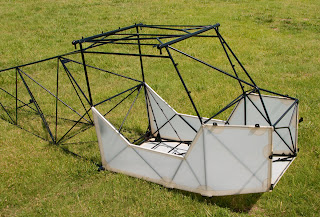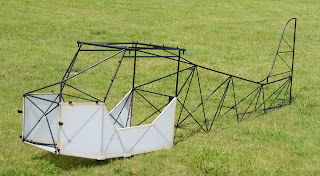 |
| Barn, from the air in a Belite Ultralight Airplane |
I've mulled about 15 different ways to write about what happened tonight. None are quite working, none express the sum of it.
Try these beginnings, even though they are inadequate:
A) I floated 400 feet over the trees and grass, all absolutely vivid green after one of the warmest and wettest spring seasons which the state of Kansas has ever seen. Every pond had a dead flat surface; the deer snuck through a field already lush, and nearly ready for harvest...
 |
| Dead flat calm on a Kansas pond |
or,
B) Stress decompression therapy involved engaging in a kind of waking dream therapy. For it to be successful, I assigned myself the task of observing stillness, green, fields and homes.
 |
| Homes in the Kansas Countryside, taken from Belite Ultralight Airplane |
C) A strip of grass, when long enough, and flat enough, provides a place to stop, and stretch, and realize that you've arrived at a place that could not have been reached and explored. OK, maybe that's pushing it, but some runways are like that.
 | |
| Grassy runway, in hayfield |
Let's twist that last one just a bit:
D) A strip of grass of a few hundred feet in length offered me a uniqueness not experienced by anyone else this evening: literally dropping out of the sky, walking in the grass, taking pictures, then rising again from that strip.
 |
| Grassy runway, somewhere near Augusta, KS |
 |
| Belite Aircraft pauses on grassy runway (WoW Plane) |
 |
| Departing from grassy runway in hayfield |
Yeah, that's Terry's runway. Sort of. Sorry I missed you: I tried to call first.
So I don't know how to write an introduction to my Evening Dream. Let's try another approach
Here's a fact based approach:
E) After flying for about 1.2 hours, I still had half a tank of gas left. This means I had been able to loiter in the sky for the evening on Two and One Half gallons of gas. My direct operating costs were about $10 an hour, using $4 / gallon gas as my cost basis. It also meant that I could plan a cross country FLIGHT of nearly two hours duration, and still have a little reserve. Emporia is now in my grasp! ....
I'm not sure what picture follows that introduction. Let's try these, even though they have nothing to do with burning 2.3 gallons per hour:
 |
| Kansas trees and bog from Belite ultralight airplane |
 |
| Scrubby ground, trees, and field, all in Kansas |
 |
| Kansas Countryside, from Belite Ultralight airplane |
 |
| Kansas beauty, from Belite ultralight airplane |
F) I had no radio, so I was very careful to look in every direction for traffic. I spotted a Stearman biplane landing at the airstrip, then saw a classic taildragger advancing around the pattern. Crossing midfield, I snuck into the pattern behind the taildragger, then landed in front of the field restaurant. Reversing course on the taxiway, the patrons nearly applauded as I taxiied by in my polka dot WoW plane.
This picture would go well with that story, so I'll let you look at it:
 |
| At Stearman Field, Benton, KS; while taxiing my Belite WoW Ultralight Airplane |
I went around the pattern at Stearman field, And I did a couple of landings there.
Here's a starting story approach which might appeal to someone who wants to know what stability this Belite airplane has:
G) I was irritated with the fact that I still hadn't set the elevator trim just right. I needed to keep some forward pressure on the stick, to keep the nose down and level. Otherwise, it just wanted to climb. Or so I thought!! Out of irritation, I let go of the stick while I played with my camera. To my surprise, the plane did something I should have known it would do: It started to climb, then eased over into a dive, then started to climb again. After four or so oscillations, it had entered a stable flight mode, slightly nose high, lower airspeed, but mushing itself through the sky in a state of equilibrium. Having released the stick, I found that I could guide the plane entirely with the use of rudder pedals only. Occasionally, I shoved a bit of aileron to keep it level. Dynamic pitch stability -- demonstrated. Should have done that a long time ago. Never had done it. Now I could write about. And speaking of technical matters, I did a two way speed pass, using my GPS to calculate average speed. The average was about 58mph in cruise, which is a new record for our little 28HP engine. (My goal is to hit 63 mph with just 28HP. I'm closing in on it, as I've made steady technical advancements on Belite aerodynamics.)
That's too technical. How about a sales pitch approach?
H) We currently have assembled planes on sale for $14,500. You can experience an evening dream like I did, but you have to be willing to part with $14,500. In return, you can write your own stories.
That just is a horrible approach. Sales pitches turn people off.
Or perhaps I could talk about the odd things spotted from the air, such as the car, or the boat, floating in a field of grass:
I) I've spotted a fair bit of odd stuff on the ground. There is *Nothing* like a small airplane, flown a few hundred feet in the sky, to spot the odd bit of man's impact on earth. Today's examples include the abandoned car and a boat, still floating in a sea of grass. I took a very nice photo of the boat. And some other photos, too.
 |
| The boat sails on. |
 |
| Windmill, Pond, Dusk approaches; taken from Belite Ultralight Aircraft |
Perhaps a nice quotation from a famous person would set the right mood to start this tale:
J) Quoting Peter Garrison: "No bird ever flew nonstop from New York to Tokyo, or raced 15 miles high at triple the speed of sound. But birds do something else. They do not conquer the air; they romance it." And tonight, I romanced the air. I found the beauty of a breathless evening; of breathtaking green; of softness; of gentleness, as not a puff of wind swayed my plane even as it hung on wind; of lightness, both in sky, in sunset, and in the touch of the earth on the plane as it floated down and touched the ground.
---
That was potential beginnings of A) thru J), which is ten different beginnings to this tale.
I don't know which way is the best way to start this article, but I do know how to end it.
Thanks for sharing my evening dream.
Terry, I'm sorry you weren't home. I would really have enjoyed seeing you. Thanks for stopping by my field earlier in the day; sorry I missed you there as well. The joy of all of this is experienced by sharing it with friends.
A last photo:
 |
| Evening dream, taken from Belite Ultralight Aircraft |
Okay, just one more photo:
 |
| Trees protect the creek and crook the field |
Good night. Sleep well. Dream.





























